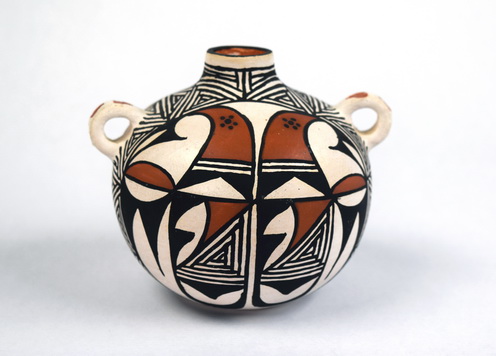Acquisition Number: 2019.7
Medium:
Clay with polychrome decoration
Size:
4 x 4 1/2 x 4 in.
Date:
c. 1990's
Credit: Gift of Tom Horner
A canteen's primary use in the Acoma Pueblo was for transporting water to the fields - the younger Acoma men were tasked with carrying canteens of water to the older men tending the crops. These canteens were highly valued possessions, because they were usually made especially for the men by their mothers or grandmothers. A drink from the canteen was measured by the amount of work the man had done. The narrow-necked shape helped prevent evaporation, while handles with straps attached made the canteens easy to carry.
This particular canteen is a modern piece that wasn't used but was instead made for decoration and the tourist market. It is, however, a fine example of the artistry of the Acoma Pueblo.
"One unique feature of Acoma pottery is that it is decorated with natural earth paints...up to the north we get our black paint, to the west we gather our clay, and to the south we get our white slip and to the east we get our yellow slip, and of course from the sky we get our rain. That's all from mother nature. Authentic pottery is not perfect. It may not be completely round, or it may not sit straight. Another way to tell the real thing is that Acoma pottery is one of the thinnest in the world."
The exact location of the Acoma's source of clay remains a tribal secret, though it is somewhere several miles west of the Pueblo.
The parrot, depicted on this canteen, has its own meaning. The parrot is a special bird that the Acoma people consider to be a leader. When Spanish foreigners entered the American southwest, they brought parrots with them. One time, a parrot got away from its owner and flew away. After a few days, the Acoma people noticed the bird flying in the same direction every day, and landing in the same place. Curious, they followed the colorful animal to the place where it landed and discovered a water hole with clean cool water flowing into it. Ever since then, the parrot appeared on many of the ollas (jars) that the women carried on their heads to transport water to the village.
The pottery of Acoma (also known as Sky City), shows the history of the Acoma people, clanship and heritage, though influenced by the arrival of Spanish Conquistadors during the 16th century. Although this pottery is known to remain consistent in its making and decoration, many artists develop their own variations of this style, which show definitive and stylistic individuality. Highly traditional, this style of pottery demonstrates the unique character of the Pueblo of Acoma and its testimony to the continuing relationship between the Acoma and the world surrounding it.
The vessels of this style are known for their complexity and variety of surface decoration, as well as rich symbolism. According to many Acoma potters, the most important element in a beautiful pot is a sense of harmony between three-dimensional form and two-dimensional design, and consider the two to intertwine. The practices were usually handed down from generation to generation, but still remain highly individualistic and creatively unique.
Like all pottery, production of Acoma style vessels is dependent on earth, water, air, and fire- the most basic of all elements. As for the production of these vessels, there are different techniques that could have been used. There is the coiled-and-pinched style, where the artist coils pieces of clay with "ropes", which is rolled out by hand, and then coiled upward beginning at the base of the structure. Another technique employed was the paddle-and-anvil technique, where a paddle was used to press the outside wall against a stone or "anvil" placed inside the vessel. All of the Acoma-style pottery is identified as either "black on white", or "polychrome"; Concho practicing in the latter. "Black on white" refers to pottery painted with a white slip on which black paint is applied in a decorative manner on top of the base. "Polychrome" refers to pottery in which several variations of earth paints in different colors have been applied on the surface. Though all vessels are vastly different in decoration, Acoma potters usually decorate their vessels with geometric elements, which represent natural elements such as rain, clouds, and animals. Surface details are applied, usually with a fine-tipped brush from the spine or leaves of a yucca plant, which is New Mexico's state flower. Like all pottery, Acoma pottery is primarily used within this culture to hold food and water, although the vessel's shape ultimately depends on the intended function. After decorating the vessel, it is fired, usually in a fire fueled by coal, dung, or sticks. Firing lasts for an hour or two and produces a vessel whose colors are richer and deeper than those before firing. Though by far the more common practice today is to use the electric modern kiln, the Acoma potters sometimes will fire outdoors the old, traditional way. To this day, many of the Acoma vessels are preferred to have been fired the old way, to give a sense of the deeply rooted and rich history of the Acoma people and heritage.
|
